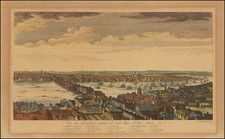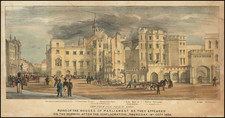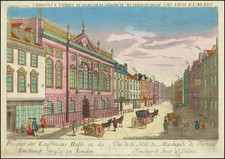One of the Best Bird's-Eye Views of London.
A handsome example of one of the great 17th-century views of London executed by the Prague-born master-engraver Wenceslaus Hollar.
The view is taken from roughly above Lambeth Palace, on the south bank of the Thames. It takes in much of built-up London north of the Thames, but one of the most charming aspects of the view is its treatment of the pastoral landscape south of the river. Along with Hollar's "Long View" of 1647, this is unquestionably one of the greatest images of the city from that period.
Hind (18) comments:
The view is taken from nearly above and behind Lambeth Palace. The river scarcely seen E. of Somerset House. Extent W., to Peterborough House (i.e. just short of Tothill Fields, which are included in the Long View of 1647).
Of particular interest as showing the fields on the S. side of the Thames.
This view is described by Parthey as London before the Fire, but I have only seen impressions showing the new St. Paul's Cathedral. These impressions all show what seems to be rework (coarsely done, and hardly by Hollar) on Sheets 3 and 4, and the town as rebuilt on the parts destroyed by the Fire. St. Paul's shows its dome, but only one of the W. Towers. The Monument is shown and a reference to the Monument (which was in building 1671-1677). It is dated 1674 in the Crace collection catalogue, but I do not know on what foundation
The two left sheets (1 and 2) show Hollar's work most purely. Unless Hollar left the other plates unfinished, one must expect to find impressions of the earlier state before the coarser rework. The plates of this subject descended to the eighteenth-century printseller Robert Sayer, and no doubt after him to his successors, Laurie and Whittle, so that late and reworked impressions are common. It was published in this late state with the impressions from each plate folded for binding.
Wenceslaus Hollar
Two features combine to make Hollar's work stand out among the great engravers of the 17th century: his sharp eye that captured a realistic view of objects, people, and places, and his wide travels, during which he made copious sketches that he later turned into engravings. Of the most important of his travels were those that he made to England, where he spent many years in the service of Lord Arundel, a great patron of the arts.
This period in England allowed Hollar the opportunity to travel extensively through the country and to produce a number of Anglo-centric engravings that are today among the most desirable of his output. This period was also a tumultuous one, with the English Civil War starting at the end of his tenure in the country. Having experienced the ruin of his own family following the Sack of Prague, the fate of his adopted country and his English patrons during the interregnum marked Hollar profoundly. Following the onset of conflict, Hollar returned to the Low Countries but continued to work on his English material. It was during this period, in Antwerp, that the Long View was produced.
Hollar continued to travel through his life and would return to England during the restoration. Yet, he never managed to again capture the success of his pre-Restoration period and would die in extreme poverty in 1677.
Dating and States
Pennington (1013) was able to discern states of the view, although neither he nor Hind were able to provide definitive dating of the states and substrates. Pennington does say that state ii was completed after 1697. Pennington and Hind suggest that in the late state the print was issued by Robert Sayer and his successor Laurie and Whittle. Based on the paper, the present example would seem to have been done circa 1760. Parthey was under the impression that the first state of the view was made before the Great Fire in 1666, though Hind questioned that. The British Museum dates the print to 1647, like so many of Hollar's other views of London.
From from left to right (1 - 4), Pendleton identifies the plates as second state, in part, by the appearance of:
- The phrase "Petterborough House" at the extreme left
- An outline view of Hamsted over Westminster
- The redesign of St. Paul's to resemble its actual, classical layout, although a tower has been omitted
- The addition of the Monument.
Wenceslaus Hollar, born on July 23, 1607, in Prague, was a prolific and accomplished Bohemian graphic artist of the 17th century.
Known to German speakers as Wenzel Hollar and to Czech speakers as Václav Hollar, he is celebrated for his masterful engravings and etchings. The turmoil of the Thirty Years' War, particularly the Sack of Prague, devastated Hollar's family, leading him to abandon his initial path towards a legal career and instead pursue the arts. His earliest surviving works date back to 1625 and 1626, showcasing the influence of Albrecht Dürer. In 1627, Hollar apprenticed under the esteemed engraver Matthäus Merian in Frankfurt, marking the beginning of his illustrious career.
During the early 1630s, Hollar resided in Strasbourg, Mainz, and Koblenz, capturing the essence of the Middle Rhine Valley through his depictions of towns, castles, and landscapes. In 1633, he moved to Cologne, where his talent began to attract significant attention. It was here, in 1636, that he caught the eye of Thomas Howard, the 21st Earl of Arundel, a renowned nobleman and art collector. Hollar joined Arundel on diplomatic missions to Vienna and Prague, and in 1637, he accompanied the Earl to England.
Upon settling in England, Hollar became part of Arundel's household, though he did not work exclusively for the Earl. He continued to create independently and for various authors and publishers. Following Arundel's death in 1646, Hollar commemorated him with a print designed by Cornelius Schut. Hollar's remarkable "View of Greenwich," published by Peter Stent, exemplified his early work in England and set a precedent for his meticulous and expansive cityscapes.
The English Civil War significantly impacted Hollar's career, although he remained productive. He withstood the siege of Basing House alongside royalist artists like Inigo Jones and William Faithorne. Despite the adversity, Hollar's output was prolific during this period, with numerous plates dated 1643 and 1644. Following his capture and subsequent escape during the siege of Basing House in 1645, Hollar relocated to Antwerp, where he reconnected with Arundel and produced some of his most acclaimed works, including cityscapes, seascapes, and intricate studies of nature.
In 1652, Hollar returned to London, continuing his work with notable publishers and illustrating various significant texts, including Ogilby's Virgil and Homer, Stapylton's Juvenal, and Dugdale's Warwickshire, St Paul's, and Monasticon.
Following the Great Fire of London in 1666, Hollar produced his famous "Views of London," capturing the city's devastation and subsequent rebuilding. In 1668, King Charles II commissioned him to document Tangier's town and forts. His return voyage included a notable naval engagement, which Hollar later etched for Ogilby's Africa. Hollar continued to produce well-regarded works until his death on March 25, 1677, in London, where he was buried at St Margaret's Church, Westminster.
Hollar's legacy endures through an extensive body of work, including some 400 drawings and 3000 etchings. His plates, numbering around 2740, encompass a vast array of subjects, from topographical views and portraits to intricate depictions of nature and architecture.
Collections of Hollar's work are held in prestigious institutions such as the British Museum, Windsor Castle, the National Gallery in Prague, and the Virginia Museum of Fine Arts. His contributions to graphic art are celebrated in catalogues by George Vertue, Gustav Parthey, and Richard Pennington, with a comprehensive catalogue published in the New Hollstein German series. Hollar's work remains accessible through digital collections, notably at the University of Toronto and the Folger Shakespeare Library.
The Wenceslaus Hollar Secondary School of Art in Prague honors his name, ensuring that his artistic legacy continues to inspire future generations.














![[London]](https://storage.googleapis.com/raremaps/img/small/72497.jpg)

